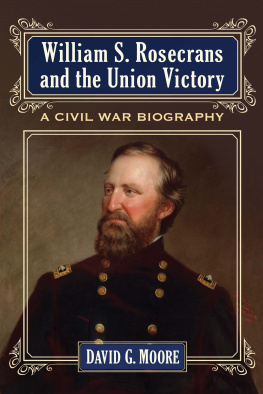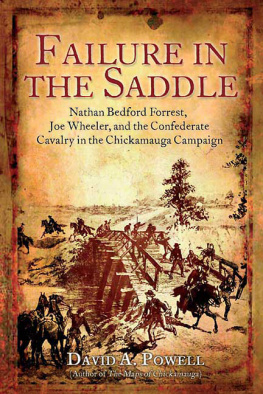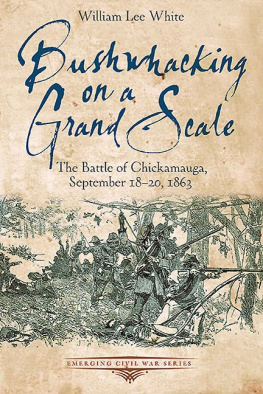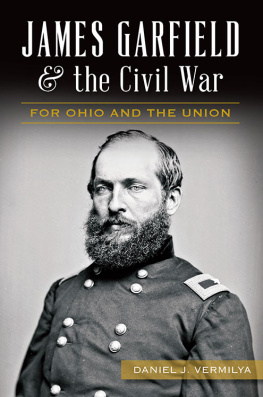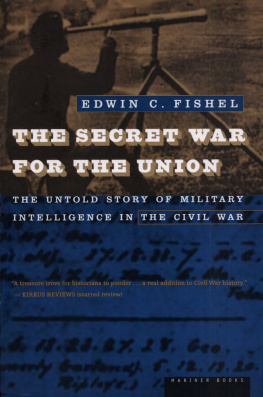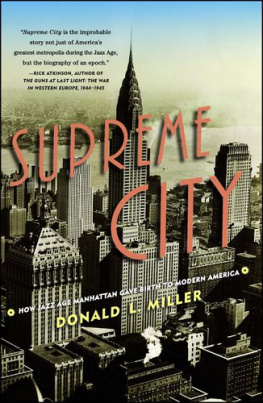
William S. Rosecrans and the Union Victory
A Civil War Biography
DAVID G. MOORE

McFarland & Company, Inc., Publishers
Jefferson, North Carolina
LIBRARY OF CONGRESS CATALOGUING DATA ARE AVAILABLE
BRITISH LIBRARY CATALOGUING DATA ARE AVAILABLE
e-ISBN: 978-1-4766-1306-2
2014 David G. Moore. All rights reserved
No part of this book may be reproduced or transmitted in any form or by any means, electronic or mechanical, including photocopying or recording, or by any information storage and retrieval system, without permission in writing from the publisher.
On the cover: Portrait of General William Starke Rosecrans by Samuel W. Price, 1868. Oil on canvas, 29 15/16" 25 3/16". (National Portrait Gallery, Smithsonian Institution/Art Resource NY)
McFarland & Company, Inc., Publishers
Box 611, Jefferson, North Carolina 28640
www.mcfarlandpub.com
To the late Cornelius (Con) F. Sheehan, with whom the voyage began many years ago so unexpectedly. I only wish he were here to see where the road led. His presence is on every page of this book.
To my family, Matthew, Thomas, Cecilia and Maggie, who willingly made libraries, battlefields and cemeteries a part of our family vacations. Thank you. We made it.
And to the boyhood friend without whose friendship the name Rosecrans would have had no meaning for me.
Acknowledgments
It would have been impossible for this book to have ever been written without the great network of libraries, public and academic, throughout the United States. Furthermore without the accessibility policy of almost every library I visited this book would not have been possible. It is a credit to this country that a person like myself, interested but uncredentialed, can have access and utilize the collections of great university and municipal libraries. Additionally the help I received from dedicated library workers in retrieving information was essential to the creation of this work. Libraries are truly one of the greatest resources of this country. Over the years as I shared the William S. Rosecrans story with friends and associates, I noticed their interest and their encouragement that I tell his story. This support was particularly important in contrast to the predominant historic view that Rosecrans obscurity was deserved. To all of you who have helped this endeavor with your words, I thank you. Your support has played a big part in its creation. If you think I may be referring to you, I am. I hope the result was worth the wait.
I want to thank Philip Mobley for the maps he formatted and created for me. I wish to acknowledge Hal Jespersens public domain maps, some of which have been adapted for this work. Access to good maps has never been easier because of the Internet and I encourage the reader to use them while reading this book.
The battle descriptions have been cobbled together from various sources. I have striven for accuracy in the details, but mistakes have no doubt crept in. The larger point of this work is not so much how these battles were fought but the important consequences of these battles which are largely unknown to the American people.
As far as sources, I have cited editions of books that can be most easily accessed by the reader. This means older editions of works that are available online are preferred to newer editions of the same works that may be difficult to obtain and consult. The purpose of this is so that the accuracy of what is written here, much of it rarely or never before cited, can be checked. If I ask for a margin of error for battle details, I invite close scrutiny of the opinions and conclusions made by the people who lived the events of 1861 to 1865.
Introduction
In 1905 a group of Civil War veterans gathered in Chattanooga, Tennesseea city they had captured and occupied forty-two years earlier in one of the key moments of the American Civil War. They were in Chattanooga for the Thirty-Third Annual Meeting of the Society of the Army of the Cumberland. That army had fought and marched across Middle Tennessee in 1863, climbing mountains and traversing rivers before fighting the Confederate Army of Tennessee at West Chickamauga Creek in the greatest battle of the western theater of the war. In the minds of these veterans, Chickamauga was not a Union defeat but rather the battle for the capture and permanent possession of the city where they were meeting, which eventually led to the capture of Atlanta and Union victory in the war.
At the third session of the meeting, an unexpected topic came up: a statue for the man who had led the Army of the Cumberland during the period of its most important battles and campaigns, Major General William S. Rosecrans.
The men began to express themselves: I worship the memory of General William S. Rosecrans. I hold for him a reverence in my heart never to be effaced, said one veteran.
He was certainly second to nobody in the army of the United States. There was no one superior to Rosecrans, said another.
A third voice added, I want to say that I think in strategy Rosecrans was not surpassed by anyone in [the Civil] war or any previous one. He secured this city in the face of a strong and powerful enemy, overcoming almost insurmountable difficulties, but he had the nerve to undertake it, and I think the success of General Grant was due to Rosecrans matchless strategy.
A fourth veteran opined, Anyone who studies the campaigns from Murfreesboro to this city, gained by his splendid strategy, cannot fail to accord to him the place of one of the greatest leaders of his age. And this statue should have a place in Washington where it will stand as long as this republic endures.
Who was this man, largely unknown to the American people today, who evoked such strong emotions and comments? To the extent William Rosecrans is known at all, it is as the defeated general of Chickamauga whose army was rescued by General Grant, who is in most accounts the general who won the Civil War.
I knew little about William S. Rosecrans until an unlikely string of events sparked my curiosity about him. More than twenty years ago a search for the grave of Lincoln assassination conspirator Mary Surratt in Washington D.C.s Mt. Olivet Cemetery led to the unexpected discovery of a gravestone which read, Ann Eliza Rosecrans, Wife of Gen. W.S. Rosecrans. I remarked to my co-explorer that Rosecrans wasnt a very good general. We wondered where General Rosecrans was entombed, and learned that it was across the Potomac in Arlington National Cemetery. That fact led to our curiosity as to why the two were buried in essentially the same city but in different cemeteries.
A short biography of Rosecrans in a guidebook to Arlington stated that Abraham Lincoln had offered the vice presidency to Rosecrans in 1864 and Rosecrans acceptance telegram had been intercepted by Secretary of War Edwin Stanton. Without that intervention Rosecrans would presumably have become president upon Lincolns assassination.
Now our interest spiked. The fact that Rosecrans was a Roman Catholic made the story even more astounding. We discovered that a biography of Rosecrans, The Edge of Glory, by William M. Lamers had been published in 1961. We read it looking for the fun trivia of the vice presidential offer but found far more compelling information about unknown, to us, battles like Rich Mountain, Iuka and Corinth, Murfreesboro, Tullahoma and Pilot Knob. Even Chickamauga became a more complex story than what we had always heard about it.
Next page
